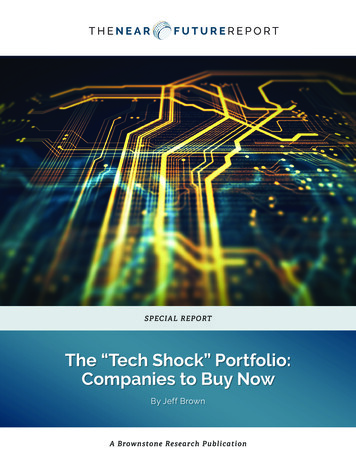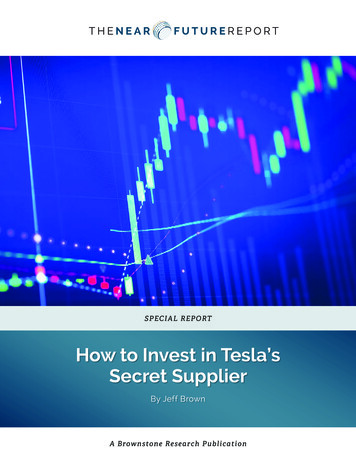
Transcription
SPECIA L REPORTThe “Tech Shock” Portfolio:Companies to Buy NowBy Jeff BrownA Brownstone Res ea rch Pub lica tion
Special Report2021The “Tech Shock” Portfolio: Companies to BuyNowBy Jeff Brown, Editor, The Near Future ReportRight now, the world is facing down amonumental shortage in semiconductors likewe’ve never seen before.moment in time when things are changing soquickly, and demand is so high, that it is hard tokeep up.Back when I worked as a high-tech executive forsome of the biggest chipmakers in the world,I saw the semiconductor industry go throughnormal boom-and-bust cycles. But whatwe’re experiencing now is different and it’simpacting daily life.The reality is that demand for semiconductors isoff the charts right now. The rate of technologicalchange continues to accelerate each week.While it’s easy to disregard semiconductors, weshouldn’t make that mistake. After all, our ownfederal government has referred to computerchips as “essential to modern day life.”That’s because semiconductors are used in manytechnology trends. They are the “brains” of allelectronics. And as technologies like artificialintelligence (AI), robotics, and 5G networksbecome more prevalent and complex, thedemand for semiconductors increases.That’s why the recent supply shortage has beencausing so much trouble.We’re experiencing shortages of the essentialchips that power our smartphones, TVs,microwaves, air conditioners, laundry machines,cars, personal computers, medical devices, andother electronics like never before It’s what I like to call a “tech shock.” That’s aThe Near Future ReportTechnology, consumer electronics, medical,industrial, and automotive companies arebringing new products to market faster thanever before. And all of these products are usingmore semiconductor content than in previousproduct generations.Nothing has been able to stop this trend. Thepandemic certainly didn’t. Even economiclockdowns couldn’t make a dent. It’s a flywheeleffect. The more advanced the semiconductors,the more advanced and incredible products canbe designed and manufactured. And with everygeneration of semiconductors, the demand formore power, functionality, and efficiency onlyincreases.And right now, the manufacturers of these chipsare playing catch up – and spending tens of billionsof dollars to build out new production capacity.Of course, this has massive implications for thevarious megatrends we follow here in The NearFuture Report.2
That’s why, in this report, I’m uncovering fourcompanies poised to profit from this tech shock.These companies are perfectly positioned tobenefit as the semiconductor shortage plays out Welcome to The Near Future ReportWelcome to The Near Future Report. Ourmission here is to profit from technology trendsthat are right around the corner. We do thisby identifying “sleep well at night” technologyinvestments that are still in “growth mode.”My name is Jeff Brown. For nearly 30 years, Iworked as a technology executive for firms likeQualcomm, NXP Semiconductors, and JuniperNetworks. I’ve earned degrees from PurdueUniversity and the prestigious London BusinessSchool.I’ve received professional certificates fromMIT, Stanford, and the University of California,Berkeley, School of Law. I’m also an alumnusof Yale University’s School of Management.And I’m an active angel investor in early stagetechnology companies.As of this writing, I’ve invested in 200 privatedeals. You might even know some of myprivate investments. I was a private investor inCoinbase, for instance, the world’s largest digitalasset exchange that recently went public.I don’t mention all this to brag. I simply wantto emphasize that I’m not a typical Wall Streetanalyst trying his or her hand at technologyresearch. I come from the industry.I’ve helped build and turn around technologycompanies – many within the semiconductorindustry. As President of NXP SemiconductorsJapan, for example, I worked closely withindustry giants like Sony to provide essentialchip sets for the latest gaming consoles and otherpopular consumer electronics on the market. It’san industry I know very well. And I’ve devotedmy entire life to researching, working with, andThe Near Future Reportinvesting in bleeding-edge technologies.And through my investments, I’m trying to helplay the foundation for the biggest megatrends intechnology right now.Blockchain technology, autonomous vehicles,cloud computing, decentralized finance, and theother trends we track in this service are seeingexponential growth That’s why I believe we’reset to profit as we invest in the companies workinghard to create the chips all of these massive techtrends will need in the coming years Tech Shock Stock #1:Advanced Micro Devices (AMD)Advanced Micro Devices (AMD) is aSilicon Valley institution. Formed in 1969, AMDdominates the computing space with its top-of-theline graphics processing units (GPUs) and fieldprogrammable gate arrays (FPGAs). We can findthese chips in a whole range of high-tech devices– from smartphones and virtual reality (VR)headsets to gaming PCs and electric vehicles (EVs).And AMD’s GPUs are driving one of the hottestmegatrends I’m tracking – the next generationof the internet. It’s what I like to call “Web 3.0.”And it’s the most consequential change that theinternet has seen in decades.Over the past year with major platforms likeTwitter and Facebook censoring or outrightbanning any voices of dissent the internet hasincreasingly become the domain of a select fewtech giants. We’ve given the majority of our data– often unknowingly – to companies like Googleand Facebook. And we’ve allowed them to profitfrom it.What have we received in return? Powerfulcompanies that have the ability and the willingnessto censor, hide, and even manipulate what we see.As our data has become more centralized aroundthese companies, we’ve seen the original promiseof a free and open internet seemingly disappear.3
But “Web 3.0” is different. It willbe decentralized, secure, and willprioritize user privacy. It will, inessence, remove the “gatekeepers”like Facebook and Google fromtheir positions of power and givecontrol back to internet users.And the advent of one keytechnology will restore the promiseof a free and open internet. It’scalled blockchain technology.As some of you may already know,blockchain technology is theunderlying technology of bitcoinand other cryptocurrencies. I’vealso referred to it as a distributedledger technology (DLT). We can think of this astechnology that securely records each and everytransaction that occurs over its network.And it’s this technology that will pave the way fordecentralized versions of the internet, the globalfinancial system, and much more.With the move toward a decentralized internet,semiconductors with lots of processing power willbe needed. And all this power will come from theGPUs and FPGAs that AMD excels at building.– of parallel computations and “infer” solutionsto complex problems on the blockchain.And in March, AMD announced a “set of fixes”to a driver for GPUs originally manufacturedexclusively for Apple. Specifically, the changes tothe GPU drivers are perfect for cryptocurrencyminers. Having GPUs specifically designedand optimized via software for miningcryptocurrency will increase the speed andcomputational abilities of these GPUs.AMD has already spent years building out theinfrastructure enabling blockchain networks.Since 2017, AMD has been designing softwarefor its GPUs to support blockchain networks andimprove cryptocurrency mining performance.AMD has also methodically courted companiesthat build hyperscale data centers to use itsGPUs to support AI/ML applications for clientsat the “edge” of a network. This is a massivebusiness for AMD, and servers powered by itstechnology are used by all of the major cloudservice providers.And AMD is already homing in on how tobest serve this lucrative market with its nextgeneration of hardware and software updates.These moves will ensure that AMD maintains alarge chunk of the cryptocurrency mining, datacenter, and AI/ML segments for years to come.Its Radeon GPUs are a big part of this strategy.Though not specifically made for cryptocurrencymining, they’re widely used by crypto minersall over the world today. They’re also theworkhorses of AI and machine learning (ML),with the ability to run thousands – even millionsAnd with its entrenched position, AMD willremain an overall leader in semiconductors overthe next decade.The Near Future ReportThe company’s revenues over the past few yearsare a testament to its dominant position in4
the semiconductor market. In the chart on theprevious page, we can see that AMD is projectedto grow its revenues to more than 21 billion by2024 – more than doubling in four years.And the majority of that growth is beingenabled by AMD’s head start in building outthe performance of AI/ML applications andblockchain technology.AMD’s growth has been and will continue tobe impressive. That’s why we should take theopportunity to establish a position in AMDand benefit from its massive share of thesemiconductor market.Action to Take: Please refer to our modelportfolio for the most current recommendedbuy-up-to price for Advanced MicroDevices (AMD). Be sure to use a limit orderwhen placing trades. For the time being,we will hold AMD with no stop loss. Alwaysremember to use rational position sizing.Risk Management: Because we will beholding AMD without a stop loss, I encourageall readers to establish rational positionsizing. We should remember to never go “allin” on any one investment. Our mission isto build a portfolio of our companies. That’show we’ll optimize our success.If this stock is trading above itsrecommended buy price, I encourage beingpatient. Regular volatility typically gives us agood entry point.Tech Shock Stock #2:Micron Technology (MU)Established in 1978, Micron Technology (MU)is one of the longest-running semiconductorfirms outside of Silicon Valley. In that time, it hasbecome a global leader in computer memory.And over the past decade, Micron has goneThe Near Future Reportthrough a major transformation. In 2010, Micronmade one of its most important acquisitionswith Numonyx, which specialized in nonvolatilememory technology. Nonvolatile memory simplymeans data can be stored and recalled even ifpower is turned off. Solid-state drives (SSDs) area type of nonvolatile memory storage.And in 2016, it acquired Inotera Memories,a manufacturer of dynamic random-accessmemory (DRAM) chips. DRAM is a type of RAM(random-access memory) technology.These acquisitions have made Micron the go-tocompany for all memory needs. In fact, it’s theonly company that offers DRAM, NAND, and3D XPoint technology. These memory chips areused in our smartphones, laptops, the guidancesystems in our cars, and many more devices.Having SSD, NAND, and 3D XPoint productsgives Micron a strong foothold in the quicklygrowing NAND industry. And Micron estimatesthat the DRAM market will grow 15% a year forat least the next couple of years, while the NANDmarket will grow 30% a year.Micron’s huge strides in the memory market haveallowed it to infiltrate another profitable segment– expanding the memory capacity of blockchainnetworks. After all, the more transactionsexecuted on the blockchain, the more memory isneeded. Cryptocurrency “miners” authenticatenew transactions daily and work to secure thechain for other users. All of these tasks requirehuge reserves of memory and computing power.Micron’s products are the key to ensuring thestability and storage capacity of blockchainnetworks across the globe.And Micron’s massive R&D spending overthe past couple of years has propelled it to aleadership position in all of its memory verticals.Last year, Micron spent over 12% of its revenueson R&D. That’s a huge amount for an 80 billioncompany like Micron.5
In the nearby chart, we can seethat Micron’s R&D spending hasincreased each year over the pastdecade, with over 2.5 billiondeployed last year alone. We canexpect Micron to maintain itsleadership position as it growsrevenues and increases its R&Dspend.With the rise in smart contracts,cross-border transactions,and Internet of Things (IoT)applications across theblockchain, Micron’s semiconductors will play adominant role in powering the next generation ofdecentralized networks.And Micron’s large array of offerings in thememory market will ensure it remains the go-tosupplier for the data centers, mining platforms,and other integral players in blockchaintechnology in the years to come.This is too good of an investment opportunity topass up.Action to Take: For our current buy-upto price for Micron Technology (MU),please see our online model portfolio. Besure to use a limit order when placingtrades. For the time being, we will hold MUwith no stop loss. Always remember to userational position sizing.Risk Management: Because we will beholding MU without a stop loss, I encourageall readers to establish rational positionsizing. We should remember to never go“all-in” on any one investment. Our missionis to build a portfolio of our companies.That’s how we’ll optimize our success.If this stock is trading above its recommendedbuy price, I encourage being patient. Regularvolatility typically gives us a good entry point.The Near Future ReportTech Shock Stock #3:Taiwan Semiconductor Manufacturing(TSM)Taiwan Semiconductor Manufacturing(TSM) is the largest semiconductor foundryin the world. Significantly, TSM producessemiconductors for companies like Qualcomm,NVIDIA, Broadcom – and even AMD – amongmany others.These contract partners essentially design theirown chips and contract the actual productionout to TSM. And this arrangement gives thesecompanies a huge advantage. It allows them tofocus on innovating their wares while leavingproduction in the hands of a trusted third party.This high volume of production has in turnallowed TSM to set new standards of quality forthe entire semiconductor industry.Just over two years ago, TSM broke ground onits Fab 18 plant. It’s here that TSM developedits 5 nanometer (nm) manufacturing process,for which it entered volume production in2020. Now, 7 nm and 5 nm processes wouldgenerally be considered the bleeding edge ofsemiconductor technology today. But TSMrecently went one step further It announced it would begin working on riskproduction of its bleeding-edge, 4 nm6
manufacturing process laterthis year. That’s at least threegenerations ahead of othersemiconductor giants like Intel.And next we’ll have 3 nm massproduction by the end of 2022.These developments show justhow fast the pace of innovationmoves at this industry-leadingfoundry.Simply put, the world runs on thechips that TSM provides throughits many partnerships. And it hasproven time and time again thatit can improve semiconductormanufacturing processes above and beyond itsnearest competitors.What’s more – TSM’s entrenched position in themarket ensures that it will remain on the leadingedge of chip manufacturing for years to come.And its manufacturing capabilities aren’t just forthe big players in tech Over 7 billion of venture capital investmenthas flowed into dozens of private, early-stagesemiconductor companies focused on AI and/orML over the past eight years. And guess what?Every single one of these companies uses TSM’smanufacturing processes. From tech giants tostartups, TSM has cornered the global market forsemiconductors.In the nearby chart, we can see that TSMholds the largest share of the semiconductormarket. In fact, this bleeding-edge company isresponsible for about 90% of the world’s mostadvanced semiconductor manufacturing. Itsnearest competitors simply can’t commandthe wealth of innovation and large productioncapacity that TSM provides.from all of the innovations being driven in thesemiconductor space. To that end, I don’t wantany subscribers to miss out on holding a positionas this industry-leading foundry builds out thenext generation of advanced semiconductors.Action to Take: For our current buyup-to price for Taiwan SemiconductorManufacturing (TSM), please see ouronline model portfolio. Be sure to use a limitorder when placing trades. For the time being,we will hold TSM with no stop loss. Alwaysremember to use rational position sizing.Risk Management: Because we will beholding TSM without a stop loss, I encourageall readers to establish rational positionsizing. We should remember to never go “allin” on any one investment. Our mission is tobuild a portfolio of our companies. That’s howwe’ll optimize our success.If this stock is trading above its recommendedbuy price, I encourage being patient. Regularvolatility typically gives us a good entry point.There is no company in the world like this.TSM is an opportunity to essentially benefitThe Near Future Report7
Tech Shock Stock #4:ASML (ASML)For our next stock, we’re revisiting a prior NearFuture Report recommendation for even biggergains: ASML (ASML). Right now, I see theperfect opportunity to jump back into this stockand capitalize on the exponential increases inspeed and stability it’s enabling in semiconductors.And it’s all because ASML is able to leveragea key piece of technology powering theincreasingly smaller and more efficient chipsbehind the key megatrends we’ve discussed –Extreme Ultraviolet (EUV) lithography.EUV scanners use a form of ultraviolet lightthat has a wavelength less than a tenth of whatwas previously used. This is significant becauseit will allow semiconductor manufacturers toprint in a single step what takes several stepswith current technology.And the difference in quality is very visible. If wewere to examine the difference with a scanningelectron microscope capable of seeing images ata nanometer scale, we would see something likethe image below.allows semiconductor manufacturers to placetransistors more precisely.And only ASML makes the equipment needed toproduce semiconductors with EUV technology.ASML’s EUV technology is used by every highend semiconductor manufacturing companyin the world. And ASML’s signature piece ofmanufacturing equipment, the ASML Twinscan,is the key factor driving its tremendous growth.The ASML TwinscanSource: ASMLThe average price per unit is 144 million ( 175million). With a 100% market share of the onlytechnology capable of producing bleeding-edgesemiconductors using a 7 nanometer (nm) processor smaller, ASML will be able to consistently growits revenues in the coming years.And its machines are already providing thecapacity needed to build out the next generationof powerful semiconductors.Last year, ASML produced 31 EUV machines. Thisyear, it expects to produce 40, and in 2022, 55.And with rising demand for cutting-edge semis,ASML’s sales team will take in many more orders.We can see a semiconductor produced usingEUV technology on the right compared totraditional methods on the left. Notice howsharp and clear the lines are on the right versuswhat we see on the left. This precision is whatThe Near Future ReportI know Wall Street is far underestimatingASML’s future sales. Based on ASML’s 2022projections, it will add 15 units of additional EUVproduction from 2021 to 2022. At a sales priceof 150 million per unit (we’ll assume a slightadjustment higher for inflation and increaseddemand), ASML can expect 2.25 billion in8
incremental revenue from justEUV sales.But that’s all the incrementalrevenue Wall Street has projectedfor ASML in 2022. They’re sayingthe rest of ASML’s business willstagnate That just doesn’t makesense to me.Rather than rely on Wall Street’sprojections, we can look backat ASML’s history of crushingrevenue expectations to see justhow valuable this company hasbecome. Look at the revenueprojections ASML laid out in 2017compared to its actual performance in the nearbychart.As we can see, ASML’s revenues haveconsistently beaten expectations over the lastfew years. We can see that management tendsto guide conservatively But it’s clear thatASML’s actual performance consistently trumpsanalysts’ expectations.And the fact is, ASML’s technology is required todrive forward innovation in every technologicalmegatrend we’ve discussed in this report. Muchlike TSM, this stock gives us exposure to almostevery segment of the semiconductor market.ASML’s technology is essential for producingfaster, more efficient semiconductors at scale– and the rest of the industry already knowsthis. With the huge sales ASML’s machines havealready seen, tech companies clearly understandthe value in leveraging ASML’s technology tousher in the next generation of powerful chips.This is definitely a company that we’ll benefit fromholding in our Near Future Report portfolio.The Near Future ReportAction to Take: Please refer to our modelportfolio for the most current recommendedbuy-up-to price for ASML (ASML). Be sureto use a limit order when placing trades. Forthe time being, we will hold ASML with nostop loss. Always remember to use rationalposition sizing.Risk Management: Because we will beholding ASML without a stop loss, I encourageall readers to establish rational position sizing.We should remember to never go “all-in” onany one investment. Our mission is to build aportfolio of our companies. That’s how we’lloptimize our success.If this stock is trading above its recommendedbuy price, I encourage being patient. Regularvolatility typically gives us a good entry point.Regards,Jeff BrownEditor, The Near Future Report9
To contact us, call toll free Domestic/International: 1-888-512-0726, Mon-Fri: 9am-5pm ET or email memberservices@brownstoneresearch.com. 2021 Brownstone Research, 55 NE 5th Avenue, Delray Beach, FL 33483. All rights reserved. Any reproduction, copying, or redistribution, in whole or in part, is prohibitedwithout written permission from the publisher.Information contained herein is obtained from sources believed to be reliable, but its accuracy cannot be guaranteed. It is not designed to meet your personal situation—weare not financial advisors nor do we give personalized advice. The opinions expressed herein are those of the publisher and are subject to change without notice. It maybecome outdated and there is no obligation to update any such information.Recommendations in Brownstone Research publications should be made only after consulting with your advisor and only after reviewing the prospectus or financialstatements of the company in question. You shouldn’t make any decision based solely on what you read here.Brownstone Research writers and publications do not take compensation in any form for covering those securities or commodities.Brownstone Research expressly forbids its writers from owning or having an interest in any security that they recommend to their readers. Furthermore, all other employeesand agents of Brownstone Research and its affiliate companies must wait 24 hours before following an initial recommendation published on the Internet, or 72 hours after aprinted publication is mailed.The Near Future Report10
a type of nonvolatile memory storage. And in 2016, it acquired Inotera Memories, a manufacturer of dynamic random-access memory (DRAM) chips. DRAM is a type of RAM (random-access memory) technology. These acquisitions have made Micron the go-to company for all memory needs. In fact, it's the only company that offers DRAM, NAND, and










